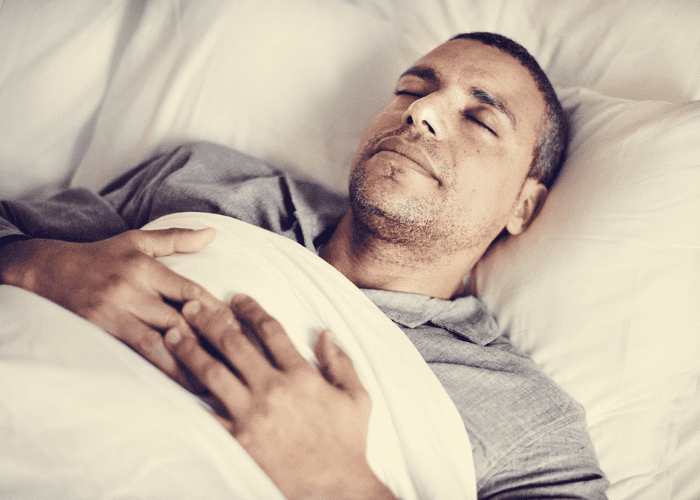Is it impossible to sleep without pain after a hair transplant? How long will my sleep be affected after a hair transplant procedure?
Hair transplants are not painful but can be sore afterward. Take standard pain medication and sleep in a position not to aggravate the pain areas on your head. After 1 month, the healing process is well on its way.
How should you sleep after a hair transplant?

In an elevated position of approximately 45 degrees. Sleeping postoperatively for anyone undergoing hair transplant surgery is a concern, and rightly so, as sleep plays a significant role in healing.
There is no sugar coating the fact that hair transplant surgery is painful, and for a couple of weeks, at least your sleep is going to be disrupted.
You will need to learn how to sleep after hair transplant surgery, but once you know the best position, you can rest, even directly after surgery.
After the procedure, your hair transplant surgeon will give you specific instructions on how to take care of the hair grafts to achieve the best possible outcome.
Along with the hair transplant surgeon’s instruction, you will be issued pain management medication to help you through the first few days postoperatively.
Good advice is to practice how you are going to sleep before your surgery when you get home after your hair graft procedure.
Sleeping at a 45-degree angle propped up on pillows is not easy, so you may find it easier to sleep if you elevate the mattress and use the pillows for support during the first few days after surgery.
You should investigate the use of orthopedic wedges. You can purchase the correct angle needed, and they are comfortable. Best of all, they are available online and can be delivered to your door.
Invariably you will have some swelling after your hair transplant, and sleeping in an upright position will encourage the accumulated fluids to drain away and reduce the swelling around your head.
In addition to sleeping elevated, your head may be weeping or oozing. This is normal, so there is no need to panic.
Have some lint-free dressings available to place on your pillow protectors; this will save staging and provide a sterile area to rest your head.
If sleep is an issue for you, try keeping your bedroom cooler than you would normally have it. Sleep with a dim light in the bedroom. You will wake during the night, and it’s a good idea to have water and your pain meds at hand.
After hair transplant surgery, it’s normal to want to touch your head! If you touch your scalp, make sure your hands are immaculate. Infection is the last thing you will want.
After 4 weeks your healing process is well underway, and you should be able to revert to your normal sleeping position if your transplant surgeon has given you the green light.
How long after FUE can you sleep normally?
About ten days and once the hair transplant surgeon has given you the green light.
Not all hair transplants are equal, and the recovery time from procedure to procedure can vary enormously.
One such procedure is fue follicular unit extraction, where hairs are harvested and grafted individually. The fue technique provides a faster recovery period.
Once the transplant surgeon has given the green light, you can normally return to sleeping in your preferred position after 10 days, which is remarkably faster than other hair transplant techniques.
However, after the hair transplant surgery, you will need to pay attention to how you sleep after a fue transplant.
Directly after surgery, you will need to sleep in an elevated position. 45 degrees is the correct angle, give or take a degree or two.
It may be best to prop the mattress up rather than rely on a bunch of pillows that can become lumpy through the night and somewhat irritating as they move around.
You can expect some oozing from the wound sites that will eventually become a crust on your scalp when sleeping.
Make sure your pillows and sheets are clean. You can cover your pillows with a clean towel if you want to absorb anything coming from the wounds on your scalp.
Alternatively, you can buy lint-free sterile dressings that are perfect for resting your heading on while protecting your pillows.
During the early days after surgery, you will be using the prescribed pain medication from your transplant surgeon. Often this medication needs to be taken on a schedule that includes through the night to maintain its efficacy.
Sleeping with a dim light and water at hand is recommended for the first few days.
How many days rest after a hair transplant?
It depends on the type of hair graft procedure you have undergone.
A fue procedure provides the fastest healing time for hair transplants. Nevertheless, your bedrest will be around 3 weeks before you can return to any semblance of your pre-operative life.
The procedure is an outpatient surgery, but it’s still invasive, so the recovery time is extensive.
Your new hair grafts will need care and attention, so you must rest and sleep well to heal fast.
For FUE grafts, you will possibly lose most of the implanted hairs during the first 3 weeks, but that does not mean the procedure was a failure.
Can you sleep on your stomach after hair transplant surgery?
It’s not advisable. You need to be elevated to allow the accumulated fluids to drain while you rest.
Sleeping on your stomach invariably means sleeping flat in a prone position. You will experience swelling around the forehead, and prone sleeping will be painful and possibly prevent the healing process.
Take the advice of your transplant surgeon and sleep in the recommended position for the best possible results.
Conclusion
Remember the points below and you’ll be fine when sleeping after an FUT hair transplant.
- Positioning: It is important to sleep in a position that allows the transplanted hair to heal properly and reduces the risk of damage to the grafts. This may include sleeping on your back with a pillow to support your head, or using a body pillow to support your head and neck.
- Sleeping on your back: Sleeping on your back can help to reduce the risk of damage to the transplanted hair and allow the grafts to heal properly.
- Using a soft pillow: Using a soft pillow can help to reduce the risk of damage to the transplanted hair and provide comfort while you sleep.
- Avoiding certain positions: It is important to avoid sleeping on your stomach or engaging in activities that could cause trauma to the transplanted hair, such as rough sports or activities.
- Wearing a protective headband: Wearing a protective headband can help to keep the transplanted hair in place and reduce the risk of damage while you sleep.
- Seeking medical advice: If you have any concerns or questions about how to sleep after a hair transplant, it is a good idea to speak to your healthcare provider for further advice and guidance.
- Caring for the transplanted hair: It is important to follow your healthcare provider’s instructions for caring for the transplanted hair, including any recommendations for shampooing and styling.
Catch you in the next one.





